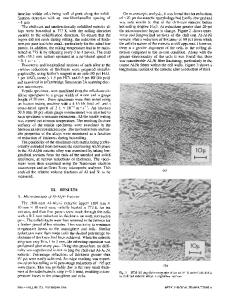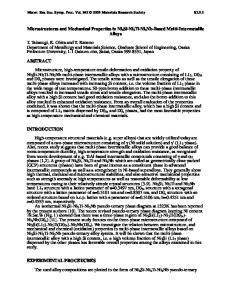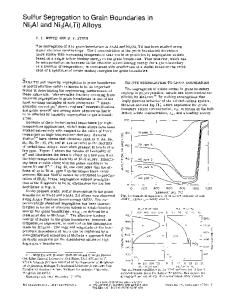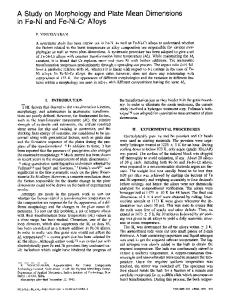Study on Cast Ni 3 Al-Base alloys
- PDF / 967,175 Bytes
- 5 Pages / 420.48 x 639 pts Page_size
- 54 Downloads / 919 Views
STUDY ON CAST Ni 3 Al-BASE ALLOYS
Zhou Yizhang, Zhang Tianxiang,Tong Yingjie, Zhang Bingda, Zhu Yaoxiao and Hu Zhuangqi Institute of Metal Research, Academia Sinica, 2-6 Wenhua Road, Shenyang, P.R.China ABSTRACT A series of cast Ni 3 Al-base alloys with the addition of alloying elements, such as Hf, Zr, Ti, Nb etc., have been studied, in which the total amount of Al and alloying elements substituting for Al was controlled in the range of 18 to 23 at%. It was found the alloying elements change remarkably the morphology, distribution and amount of y phase as well as the morphology and size of primary -e' intermetallic compound. The size of primary-(' can be decreased to micron order. The brittle Y'-( boundary (refer to primary)e') can be substituted by tough Y'- 2- Y' boundary. As a result, the mechanical properties of the cast Ni 3 Al-base alloys, especially high temperature ductility, can be enhanced. In addition, the effect of Cr is discussed when tested in air environment,and considered that chromium addition is not very effective to improve the high temperature embrittlement. INTRODUCTION Intermetallic compound Ni3AI is a kind of new high temperature material for structural use. Recently, a series of Ni3Al-base alloys have been developed. Although Ni3Al has many advantages, polycrystalline Ni3Al alloys suffer from the severe problems of poor ductility and intergranular embrittlementl, 2 , 3 . That is mainly due to inherent fragility among grain boundaries because of poor grain boundary cohesion 4 ,5, 6 . K. Aoki and 0. Izumi 7 discovered that the room temperature ductility of Ni3Al is significantly improved by addition of boron. C.T.Liu 8 , 9 and S.C.Huang 10,11 reassured the effective function of boron, and found that boron addition is effective in improving ductility and suppressing intergranular fracture in Ni3AI alloys containing 24 at%Al, but is ineffective in alloys with 25at%Al. Room temperature embrittlement of Ni3A1 alloys has now been solved, and the elongation is more than 50%. But, high temperature embrittlement (600°C850°C) has not yet been improved, owing to the embrittlement of grain boundaries. So it is considered;that embrittlement is the key problem for structural materials used at elevated temperatures and has to be solved before Ni3Al-base alloys being used at high temperature. This paper will study the substitution of tough y'- Y-j'boundaries for brittle )'-y' boundaries by means of alloying. In the meantime, the relations among composition, microstructure and high temperature ductility of Ni3Al-base alloys are studied, and especially the effect of Cr on high temperature ductility of Ni3Al-base alloys has been discussed when they are tested in air -environment. EXPERIMENTAL PROCEDURES Table 1 is the nominal compositions of Ni3Al-base alloys studied. The cast bars were produced by VIM and Investment casting, and then fabricated to tensile specimens. The tensile tests were performed in air at 600 0 C and 850 0 C respectively, the tens ile strain rate is 2.5 mm/mmn.
Mat. Res. Soc. Symp. Proc.
Data Loading...











